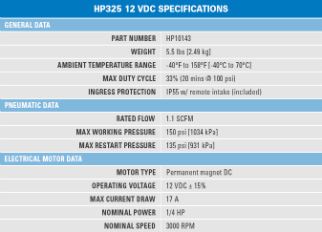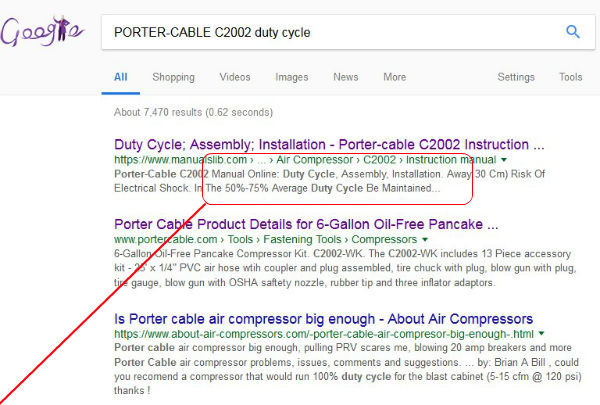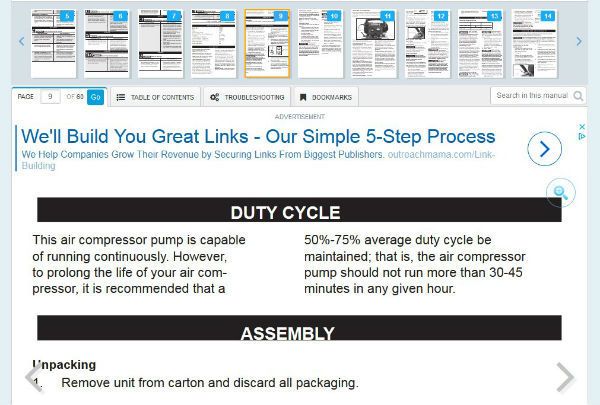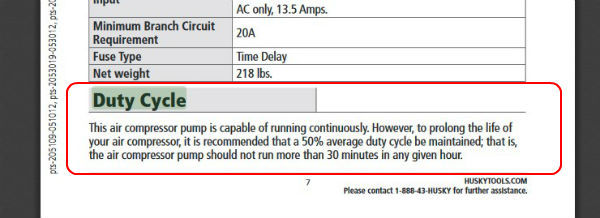The duty cycle rating for an air compressor is another one of those terms that can make the decision process of choosing the right model, that much more difficult...
Am I Right?
I wanted to explore the topic more and once I did, I learned a lot about the subject and figured out that it isn't all that hard to figure out.

I gathered all of the information I could (on air compressor duty cycles) and organized it. I gave a few examples, which really helped me understand the "average duty cycle" for most compressors and what the term REALLY means. I hope you find the information useful!
What Is "Duty Cycle" On An Air Compressor?
Duty Cycle is a term that is used (related to air compressors) that tells you how long the compressor is rated to run for versus how long it should rest and an overall gauge for how "heavy duty" the motor is (in general).
If we use 1 hour of time as an example, a 30% duty cycle compressor would be rated to handle 20 min. of use and a rest period of 40 min. (approximately).
The Different Duty Cycles Explained...
The duty cycles of an air compressor are pretty easy to understand and explain as long as you have the basic principle in mind. Remember that the duty cycle is basically the amount of time the air compressor can run for, compared to the time it needs to rest.
The "standard" for testing the duty cycle of an air compressor will include a controlled temperature (72° F) and will be tested at a pressure of 100 PSI, in most cases.
Let's use a couple of examples to further demonstrate the duty cycles related to air compressors. I will use an hour as a measurement of time to make the example easier to understand and more relatable to real world working environments.
- A 100% duty cycle compressor (or continuous use) can run all the time without needing any rest whatsoever. These are typically oil lubricated compressors that have larger, more durable parts and are a big part of the reason why they can run continuously.
Manufacturers will recommend a duty cycle of around 50% though to prolong motor life. - A compressor with a 75% duty cycle rating can run four. Of 45 min. and will have to rest for 15 minutes. These provide adequate working time and very minimal downtime and are a good choice for professionals or people who will use air tools that require a lot of air (higher cfm output).
- A 50% duty cycle compressor is able to run for around 30 min. and will have to rest for that same period of time. This ratio is not recommended for the higher demanding air tools but if you are going to use them I would recommend using them and shorter durations instead of constantly, to avoid too much downtime waiting for the compressor to fill up again.
- A compressor with a 25% duty cycle rating can run for approximately 15 min. and will have to rest for 45 minutes. These compressors are not really recommended for tools they require a lot of air and will work best for air tools that require short bursts of air instead of a constant air supply.
The duty cycles really are geared more towards an air tool that uses a lot of air or one that will be constantly running. If you are using a tool or tools that do not need constant air flow, then duty cycle will not be as important.
How Do I Find The Duty Cycle Of My Compressor?
The duty cycle is not usually a metric that manufacturers or retailers include in their product listing so it is hard to find duty cycle ratings on retail websites and even some manufacturers websites, from what I gathered researching this on my own.
I was able to find quite a few different ratings from a few different sources but the key was how I found it not where I found it. So if you are having trouble locating the duty cycle for your air presser I would recommend doing the following:
- Go to Google.com (or another search engine like Yahoo or Bing)
- Type in your compressor make and model number
- After your model number, insert the words "duty cycle" (without quotes) to see what pops up.
* I will give you an example of how to do this using a popular air compressor, the Porter Cable C2002. For this example I will be using Google to search for the duty cycle of this Porter Cable air compressor.


Not all of the cycle duty specs relisted on the types of websites that I found in the above example. Some were listed on manufacturers websites as well. You may have to look harder to find the information you need for some models and every now and then you may not even find using this method.
Can I Calculate The Duty Cycle Myself?
I did not find anything online that would lead me to believe that I can calculate the duty cycle of my air compressor myself but if I find any information on this in the future, I will update this article and keep you posted on what I find.
If you know how to do this yourself, please let me know in the comments below and I would be happy to look into it further and post any relative information on the subject as well.
A Few Examples That Might Be Helpful:
I wanted to look at a few different air compressors (popular models) to get an overall idea of what the "average" duty cycle rating for specific types of compressors. I think it'll help give me a general idea of what to expect and I always like to see the big picture anyways, because it makes things a lot simpler.
Portable Compressors: Most of the portable compressors had a duty cycle rating of around 50%, which was recommended by most of the manufacturers and in my opinion, a really conservative estimate but I'm sure the manufacturers want their tools to last as long as possible and 50% is probably a good number for this very reason.
Most of the portable compressors I looked at were some of the more popular models, priced between $100 and $200 and had some of the highest number of reviews from many different retail websites. These included pancake compressors, hotdog compressors in just about every other type that would fall under the "portable" category.
Stationary Compressors: When I looked at some of the different stationary air compressors, I found a little bit more mixed ratings as far as the duty cycle is concerned but still pretty straightforward, for the most part.
I found that some models stated that a 50% duty cycle was recommended, to preserve the motor life just like I saw with the portable type of compressors. Other models had a duty cycle rating of 75%, which were typically the 240 V models and makes sense.
I also found one model that was quite large but was also quite expensive (around $2,500) that had features that would help whenever operating an airtool (continuously) over the 50% (recommended) duty rating.
The exact quote was: "Continuous mode functionality for workloads over 50% duty cycle eliminates wear and tear on your magnetic contactor" from Home Depot's website.
Things To Consider:
This article outlines some of the general information related to duty cycles and air compressors but there are a couple of things that you should keep in mind when considering duty cycles in general.

- A 100% duty cycle rated compressor can maintain a constant airflow but can only maintain a constant airflow at specified PSI and CFM rate. Even an air compressor that has a 100% duty cycle rating can become damaged if you are over exerting its capabilities using an air tool it requires too much CFM or PSI. There is a great article on this that goes into greater detail.
- Remember that the easier he will are on your compressor, longer it will last and the better overall performance you'll get from it over time. You will want to let the compressor rest is often as you can in order to let it recoup and rest a little while. This will greatly improve the life of your compressor and its motor.
- Remember that the standard tasks for duty cycles are done at 100 PSI and in a temperature controlled environment of 72°F. If you are in hotter or colder weather this will affect the air compressors overall rating and in most cases will reduce this metric, just something to be aware of.
- In most cases, an air compressor is usually damaged because of overheating issues which is caused by overexertion on the motor itself, from pushing it too much in one area or another. Larger compressors that have more tank capacity, a high duty cycle rating and lots of CFM output are the best kinds to get but are also the most expensive.

